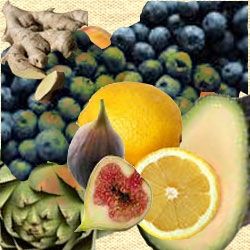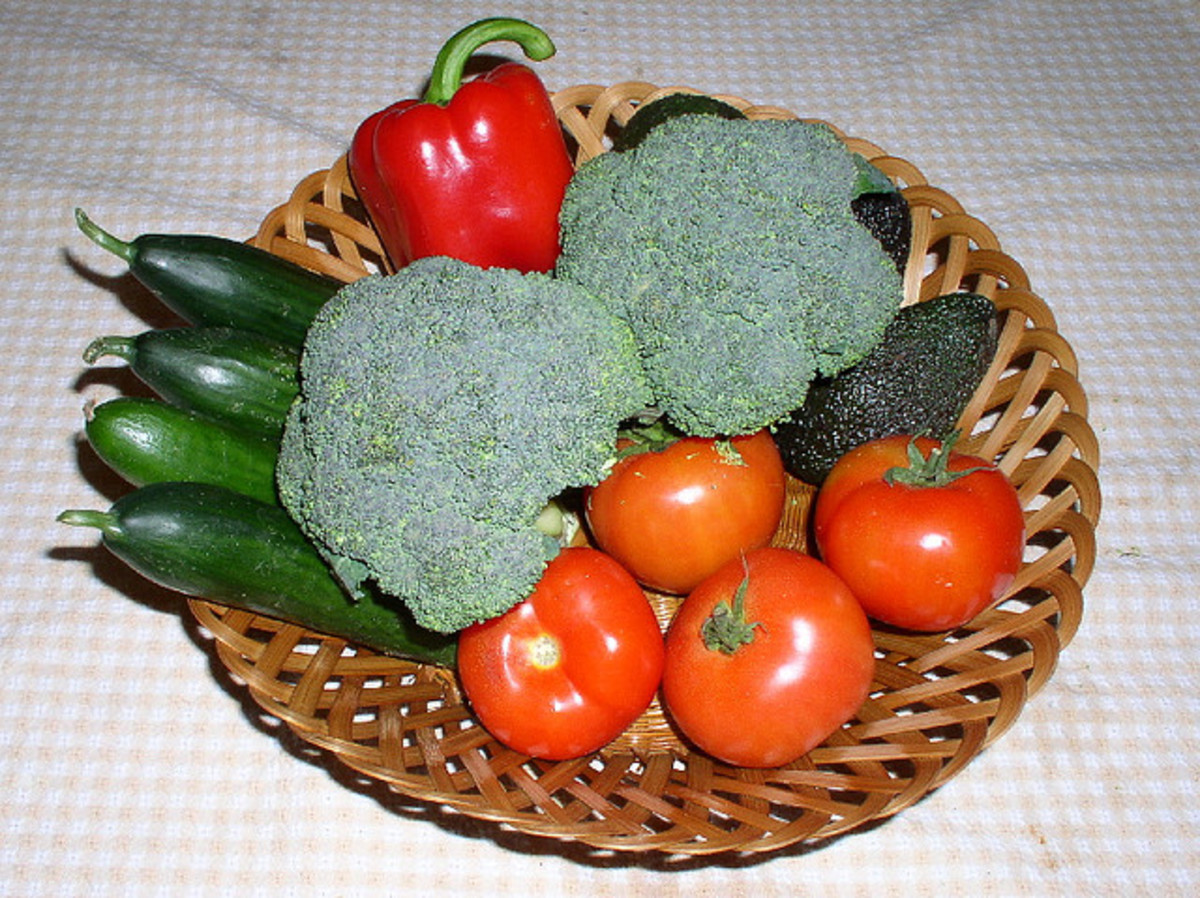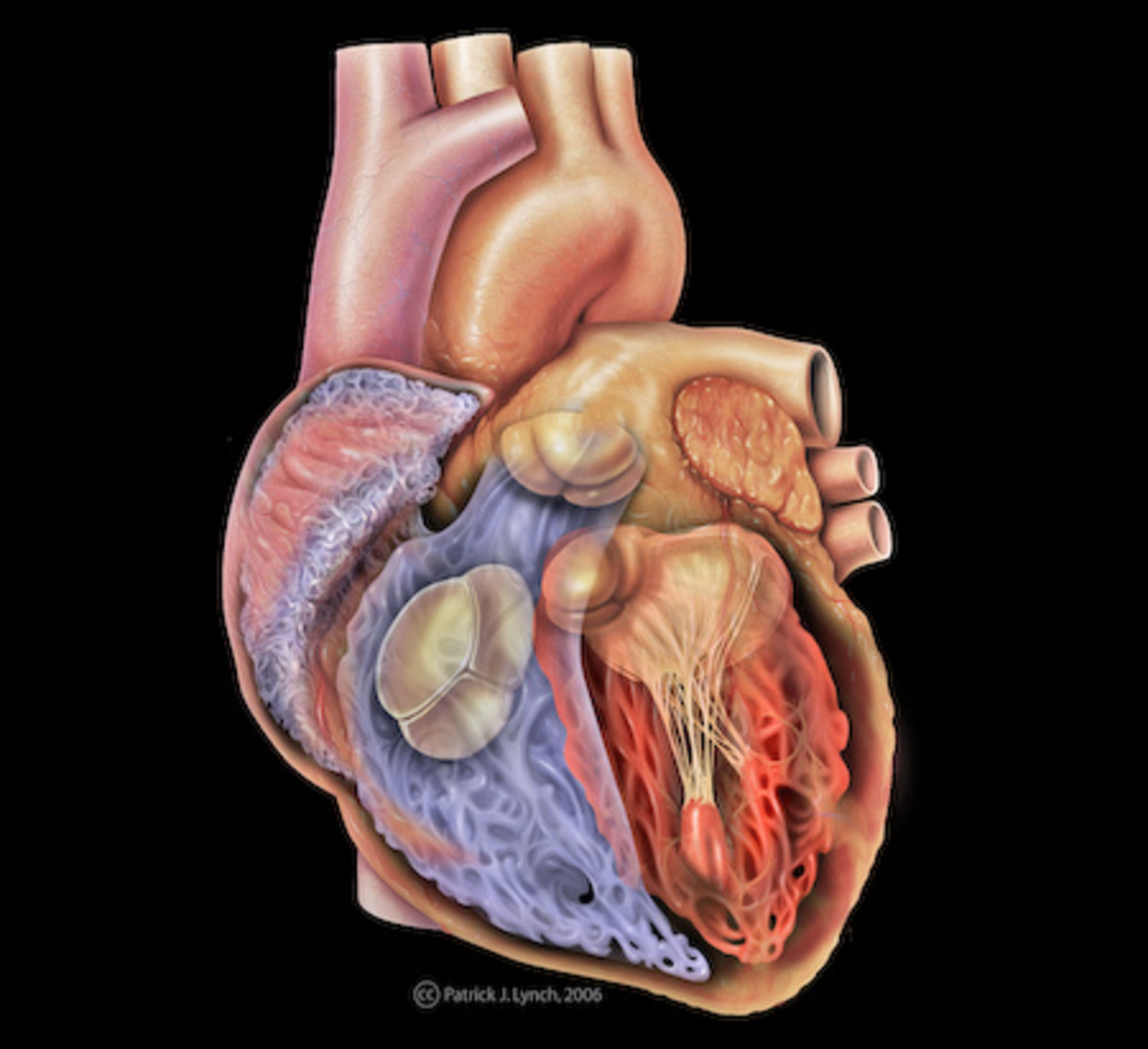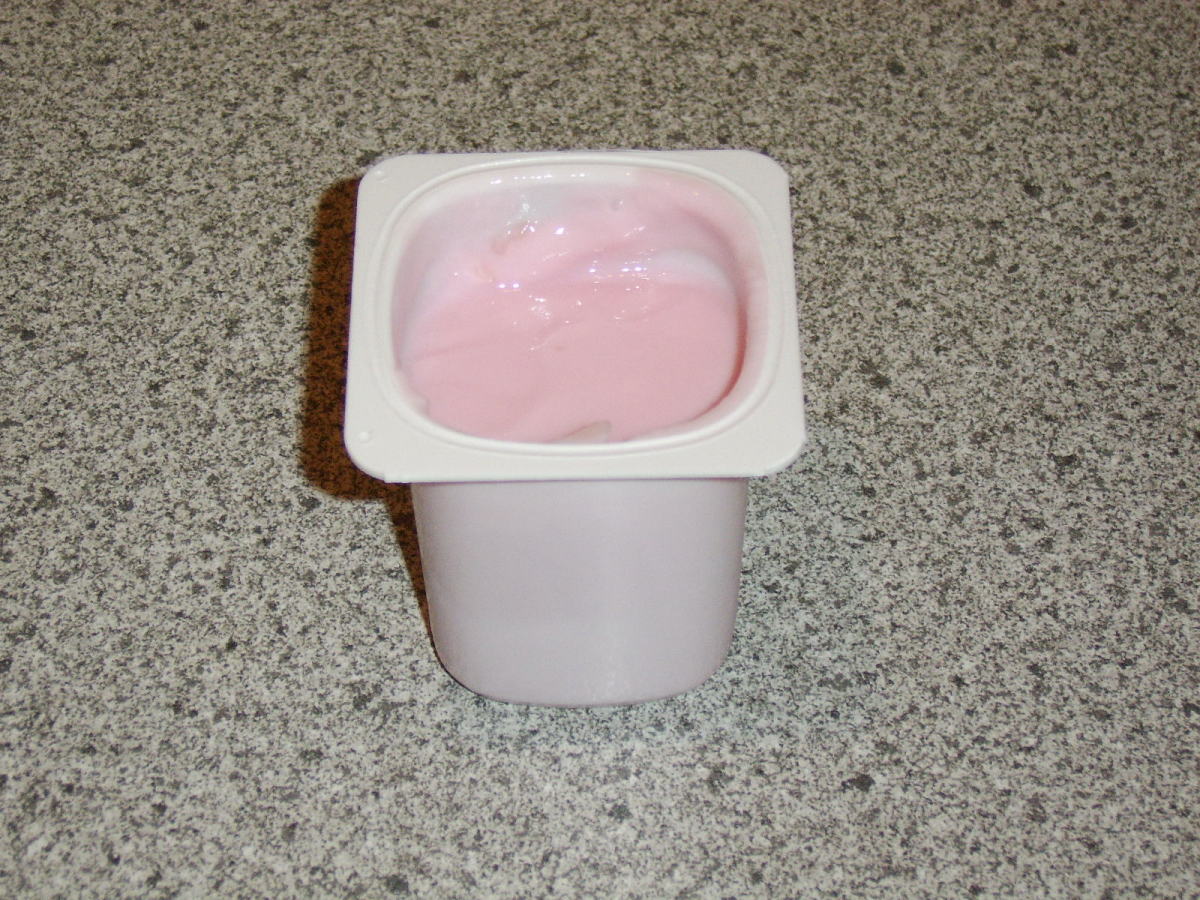Top 10 Healthful Foods

Eating a rainbow for health
All fresh fruits and vegetables are good for you. Some are even better for you though. Its oft been said to "eat a rainbow". I've selected then 10 fruits and vegetables that have the most nutritious bang for their buck, trying to be representative of all the colors and this is what I've found.
Tomatoes get their red color from the powerful betacarotene, lycopene. Lycopene acts as an antioxidant, neutralizing free radicals in the body that cause damage. Tomatoes contain Vitamin A, Potassium and Iron. They are also high in Vitamin C content.
Eating tomatoes has been shown to reduce the risk of acquiring the following cancers: prostate; stomach; rectal; colon; lung; breast and endometrial. Both Coumaric Acid and Cholorogenic Acid (both found in tomatoes) are shown to block the effects of nitrosamines, the strongest carcinogenic in cigarettes. Raw tomatoes have also appeared to help older people stay active for a longer period of time.
Tomatoes don't have their nutritional value diminished with high-heat processing and are thus just as nutritionally beneficial in canned or sauce varieties. In fact, cooking tomatoes in a small bit of olive oil increases the release of lycopene and also the increases the absorpability of that lycopene into your body.
Suggestions for increased tomato consumption: fresh tomato salsa, bruschetta, caprese salad, tomato soup
Sneak tomatoes into your kids foods with: spaghetti, pizza, tomato slices in grilled cheese sandwiches, lasagna (use both sliced tomatoes and sauce)
Blueberries have one of the highest antioxidant levels of all the fruits. The anthocyanin compound found in blueberries is what gives them their color: it is also what appears to be responsible for neuron protection and both antioxidant and anti-inflammatory properties. In animal studies, blueberry-fed mice performed better in motor behavioral learning and memory and increased exploratory behavior. Brain examination displayed two regions with less oxidative stress than the control group as well as better retention of signal-receiving neurons. In current human tests, people eating 1 cup or more of blueberries daily are faring between 5% and 6% better on cognitive tests.
Anthocyanin's antioxidant activity has been shown to benefit more than brain function. It is named as a good preventative measure for: glaucoma, varicose veins, cataracts, hemorrhoids, peptic ulcers, heart disease and cancer.
Blueberries contain one of the highest levels of kaempferol among vegetables and fruits. Diets containing kaempferol have been associated with a 40% reduced risk for ovarian cancer.
Suggestions for increased blueberry consumption: top yogurt with blueberries and 1 tbsp. wheatgerm,
Sneak blueberries into your kids food with: blueberry pancakes, blueberry muffins
Figs have the highest mineral content of any fruit. A low intake of potassium, coupled with a high intake of sodium can lead to hypertension. Not only that, but a high sodium diet leaches calcium from your system. The high potassium content in figs in connection with a diet featuring more fresh fruit and vegetables and less fat and salty snacks, can aid in lowering your blood pressure. Figs are also high in calcium. Dried figs contain more calcium than whole milk! The potassium content in figs helps to prevent calcium loss. Figs are also one of the most alkaline foods available, vital for balancing the pH of the body.
Figs have been found to be beneficial in weight loss with their high dietary fiber content. Fiber-rich foods are thought to keep your hunger levels lower. Increased consumption of fruit fiber (as opposed to bran fiber) has also been linked to a lowered risk for breast cancer in women. In fact, figs contain both soluble fiber and insoluble fiber. Insoluble fiber protects against both breast and colon cancer. Soluble fiber helps to lower blood cholesterol. Figs high fiber content also contributes to healthy bowel function.
Choose fully ripened figs to gain the most benefit of their antioxidants. Figs are highly perishable, so when purchasing ripe figs you should plan to eat them within one to two days. Ripe California figs are available June through September and some European varieties are available throughout the autumn. Dried figs are available year-round.
Its not only the fruit of the fig that's good for you. Fig leaves have antidiabetic properties and can reduce the amount of insulin needed by those diabetics requiring insulin. Studies with animals have also shown that fig leaves lower levels of triglycerides (fat circulating in the blood stream) and also inhibit the growth of certain types of cancer cells.
As an adult, your best bet against macular degeneration (vision loss) is a high intake of fruits. Whilst vegetable intake, carotenoids and antioxidant vitamins A, C and E showed no effect in the fight against macular degeneration, fruit consumption figured high. Eating figs helps you to easily meet your goal of 3 servings of fruits each day.
Suggestions for increased fig consumption: sprinkle either fresh or dried figs on porridge or oatmeal, add chopped figs to green salads, stuff fresh figs with goat cheese and almonds for an appetizer or dessert, figs poached in fruit juice or red wine can be served with yogurt or other frozen desserts. Fig paste can also be used as a healthy sweetener or fat replacement in recipes.
Sneak figs into your kids food with: fig bars, fig butter to spread on bread or crackers, dried figs added to baked goods such as muffins and cakes.
Figs contain oxalates and should be avoided by those with untreated gall-bladder or kidney stone problems. Dried figs may also be exposed to sulfites, which can be problematic for asthmatics.
Thiosulfinates in onions make it antimicrobial: onions are effective against E.Coli, Salmonella and Bacilus Subtilus bacterias. Onions are full of fructo-oligosaccharides. These oligomers encourage healthy bifidobacterial growth and suppress the growth of potentially harmful colon bacterias (as well as reduce the risk of tumor growth in the colon). Quercitin (a flavinoid in onions) inhibits the growth of colon cancer cell lines and abnormal colorectal cells in animals. Further, patients consuming large amounts of onions show reduced risk for the following types of cancers: oral cavity & pharynx, esophageal, colorectal, laryngeal, breast, ovarian, prostate and renal. Women consuming kaempferol (found in onions) have a 40% risk reduction for ovarian cancer. Antimicrobial agents in onions reduce the severity of pain from both rheumotoid and osteo-arthritish, asthmatic inflammatory responses and respiratory congestion from common colds. The quercitin in onions works with Vitamin C to kill harmful bacteria.
Women at risk for osteoporosis will additionally find benefit in eating onions through GPCS (gamma-L-glutamyl-trans-S-1-propenyl-L-cysteine sulfoxide). This compound with the long name is found in onions and inhibits osteoclast activity. Osteoclasts break down bone.
Onions are rich in flavonoids, useful in protecting against cardiovascular disease. The high sulfur content in onions (sulfides) is potentially to blame for onion consumption being linked to low blood pressure and blood lipids (fats). Onions are natural anti-clotting agents, supressing platelet clotting. Increased onion consumption is linked to lower cholesterol and lower blood pressure levels, Onions have been named as one of a small number of foods (apples, broccoli, tea and onions) shown to significantly reduce the risk for heart attack and stroke. Through the combined work of onions' sulfides, vitamin B6 and chromium, high homocysteine levels are lowered, decreasing yet another major risk factor for heart attack and stroke.
Increased onion consumption has been linked to prevention of stomach cancer. This is based on regional studies conducted in Vidalia, GA (USA), Greece, China, India and The Netherlands linking local onion consumption with stomach cancer rates. The flavonoid Quercitin has been named as a good preventer of colon cancer: cooking meats with onions has been shown to reduce the amount of carcinogens produced when cooking via high-heat methods. Both quercitin and curcumin (found in turmeric) can reduce both the size and number of precancerous lesions in the human intestinal tract. Quercitin is used as treatment for FAP (familial adenomatous polyposis) producing the results of the number of developing polyps reducing by over 60% and the size of developing polyps reducing by over 50%.
Finally, eating onions is of special importance to diabetics. Onions appear to lower blood sugar levels by increasing the amount of free insulin available. Allyl Propyl Disulfide (present in onions) competes with insulin for occupancy in liver areas responsible for insulin inactivation. The result is an increase in available insulin and subsequent lowering of blood sugar. Chromium, of which onions are a great source, helps the body to respond appropriately to insulin. Chromium deficiency is a problem in the United States: chromium is depleted by refined sugars, white flour products and a lack of exercise. Just one cup of raw onions provides over 20% of the daily value for chromium. Chromium has been shown to decrease fasting blood glucose levels, improve glucose tolerance, lower insulin levels, decrease total triglyceride and cholesterol levels and increase HDL-cholesterol (good cholesterol) levels.
Suggestions for increased onion consumption: fresh salsa (pico de gallo), raw chopped onions in salads, on your bagel, sliced in a sandwich
Sneak onions into your kids food with: french onion soup, omelettes, inside grilled cheese sandwiches, grated into coleslaw, in egg salad
Onions with more astringency and flavor contain more antioxidants. The sulfur-containing compounds responsible for their pungency are also responsible for their health benefits.
Just 1/4 cup of lemon juice provides the body with 45% of its recommended daily allowance for Vitamin C. Vitamin C is a powerful antioxidant, destryoing free radicals that contribute not only to osteoarthritis and rheumatoid arthritis, but even dull eyes, wrinkles and a lack of muscle tone. The water-soluble form of Vitamin C, L-Ascorbic Acid, aids in the restoration and production of collagen. Collagen, of course, is vital to healthy skin.
Going deeper than the skin, Vitamin C and its associated antioxidants destroy free radicals that damage the blood vessels. Damaged blood vessels is a precursor to atherosclerosis, often ending in heart disease and stroke.
Aside from the Vitamin C benefits, lemon is also a diuretic, tonic and antibacterial agent. Lemon juice stimulates the production of enzymes and bile: this of course aids digestion. Lemon has also been shown to relieve constipation, UT infections and heartburn. The citric acid in lemon has blood-cleansing properties and is even used as a poison antidote in some cultures.
When choosing your lemons, look to those with thinner skins as they have a higher mineral content then lemons with heavy rinds.
Suggestions for increased lemon consumption: a squeeze in your water, squeeze on steamed vegetables, use to tenderize chicken or flavor fish, add grated lemon zest to desserts or yogurt
Sneak lemons into your kids food with: lemon juice frozen in ice-cube trays and added to drinks, lemon curd
Increase the benefits of green tea catechins by adding a squeeze of lemon to your cup. Double duty antioxidants!
Avocados are bursting with monounsaturated fats (also found in olive oil), which are linked to lowered LDL cholesterol levels and weight loss. The New England Journal of Medicine found that the healthy-fat diets are more effective for weight-loss than fat-free diets in a recently published longitudinal study of theirs. Avocados do still pack a high caloric punch however, so be sure to use them in moderation.
Additionally, avocados contain beta-sitosterol, which has been shown to lower blood cholesterol levels.
Suggestions for increased avocado consumption: replace sandwich spread with avocado slices, use mashed avocados on bagels instead of cream cheese
Sneak avocadoes into your kids food with: guacamole, a few slices at the bottom of a taco or burrito, sandwich spread, mashed into egg salad for sandwiches
Ginger is best known for curing digestive complaints and nausea relief. Ginger has also been found to assist with arthritis treatment, prevent blood clotting and lower cholesterol. Some evidence is also pointing to anti-cancer activities.
Ginger promotes bile flow. The improved bile flow helps to calm upset stomachs, reduce nausea, minimize menstrual cramping in women, fight indigestion and relieve bloating. It alleviates gas, cramping and heartburn. Ginger has been effectively used to treat sea sickness and motion sickness. It is also known to be beneficial in treating gastric ulcers, as well as lower cholesterol.
Ginger improves blood circulation in the pelvic region and has been connected with better fertility.
Suggestions for increased ginger consumption: make ginger tea, use it as a complement to garlic - always or even replace your garlic with ginger!
Sneak ginger into your kids food with: candied ginger on frozen yogurt, use it in addition to garlic, whenever! (try ginger bread even)
Ginger can potentially act as a blood thinning agent.
Eggplants are teeming with antioxidants. Nasunin is an antioxidant of the flavonoid variety (also a phytonutrient) and has been the focus of studies concerning the eggplant's antioxidant value. Nasunin is an extremely efficient free radical scavenger as well as being an excellent protector of cell membranes and lipids in brain cells. Cell membranes are composed almost entirely of lipids and not only protect the cells from damage, they also control the flow of nutrients into a cell and the waste flow leaving the cell. Because of these protective factors of nasunin, it makes eggplant a good brain food.
Nasunin is not only an efficient free radical scavenger, it also proactively inhibits the production of damaging free radicals. Nasunin is an iron chelator, meaning it helps the body dispose of iron. Although iron is an essential part of our diet, too much of it is associated with heart disease and cancer (due to its encouragement of free radicals). This is particularly important to men and post-menopausal women, both of whom have a more difficult time ridding the body of excess iron. Nasunin protects blood cholesterol from peroxidation, inhibits cellular damage from free radicals and lessens free radical damage in joints (playing a huge factor in the easing of rheumatoid arthritis).
Nasunin, along with several other phytonutrients, has been shown to lower cholesterol and improve blood flow in animal studies. Animals given eggplant juice were shown to have reduced cholesterol in their aortas, reduced cholesterol in their artery walls and reduced blood cholesterol. The blood vessel walls also relaxed, further improving the blood flow.
In addition to nasunin, eggplants are chock full of phenolic compounds functioning as antioxidants. Of these phenolic compounds, chlorogenic acid is the most abundant one. Chlorogenic acid is also one of the best free radical scavengers around, having antimutagenic (anti-cancer), antimicrobial, anti-LDL (bad cholesterol) and antiviral properties.
The "Black Magic" variety of eggplant was shown to have three times the antioxidant values of other eggplant cultivars.
Suggestions for increased eggplant consumption: Use babaganoush (eggplant, lemon juice, garlic, tahini and olive oil) as a dip or sandwich spread, add eggplant to stir-fries
Sneak eggplant into your kids food with: Ratatouille (they'll like the name)
Artichokes contain caffeoylquinic acids, one of which is called cynarin. It is mainly found in the leaves, but also occurs in the bracts and heart.
Choleretics are found in artichokes. Due to the appearance of choleretics, the flow of bile both to and from the liver is improved with the consumption of artichokes. Choleretics are very useful to people experiencing liver problems, such as those diagnosed with hepatitis. The choleretics found in artichokes also help in lowering cholesterol: they increase cholesterol excretion and hamper the production of new cholesterol in the liver.
Suggestions for increased artichoke consumption: Add artichoke hearts to your salads,
Sneak artichokes into your kids food with: spinach & artichoke dip
Artichokes are particularly beneficial to diabetics as they contain a carbohydrate in the form of insulin.
Vitamin A intake can reduce your chances of developing cataracts by 40% or more. Vitamin A is also a powerful antioxidant, preventing tissue and cellular damage done by free radicals: the lenses in your eyes in particular can be damaged by free radicals. Vitamin A's antioxidant properties prevent damage to the blood supply for the eyes and also fight against the formation of cataracts (caused by free radicals). Apricots give you 50% of your daily recommended allowance for vitamin A.
Apricots additionally have high beta-carotene and lycopene activity. This is related to the prevention of LDL cholesterol from oxidation. The oxidation of LDL cholesterol is linked to heart disease.
Dietary fiber is found in fruits such as apricots and is important in maintaining digestive health: preventing constipation and conditions such as diverticulosis.
Dried apricots actually contain more nutrients than their fresh counterparts!
Suggestions for increased apricot consumption: Add dried apricots to your cereal or green salad.
Sneak apricots into your kids food with: dried apricots in trail mixes with other nuts and some chocolate chips, dried apricots in baked goods such as muffins, as a topping for pancakes (with some whipped cream and syrup)
Whether you're looking for a natural and homeopathic cure to your ailments, want to live a longer and more fulfilling life, are looking to increase your energy or lose weight, you should read about food and its healing powers / health benefits. When you understand what you're putting in your body, you can better control what results you get.
You Are
What You Eat
Share Your Story.
Sign up at Squidoo.
Sign up at Squidoo and make your own lens! Do you have some healthy eating tips? Healthy recipes you'd like to share with the world? A fitness or weight-loss success story you'd like to share with the world? Be sure to sign up at Squidoo and make your own 'lens' about it!
Squidoo Affliations - I'm a member!

What do you think about this top 10 list for healthy foods? Do I have it on the mark or do you feel I left out an obvious choice? Do you have a good recipe to make use of and include these 10 health powerhouses? Say it here!
Contact Laura Schofield
*If you would like to suggest any links or have your own photos and / or stories published, please send me an email. I can be contacted through my personal homepage, laura-schofield.com. If you enjoy the work I've done here, I do offer professional copy writing, photo restoration / manipulation, search engine optimization and web design services. I can again be contacted for any of these services through my website.












